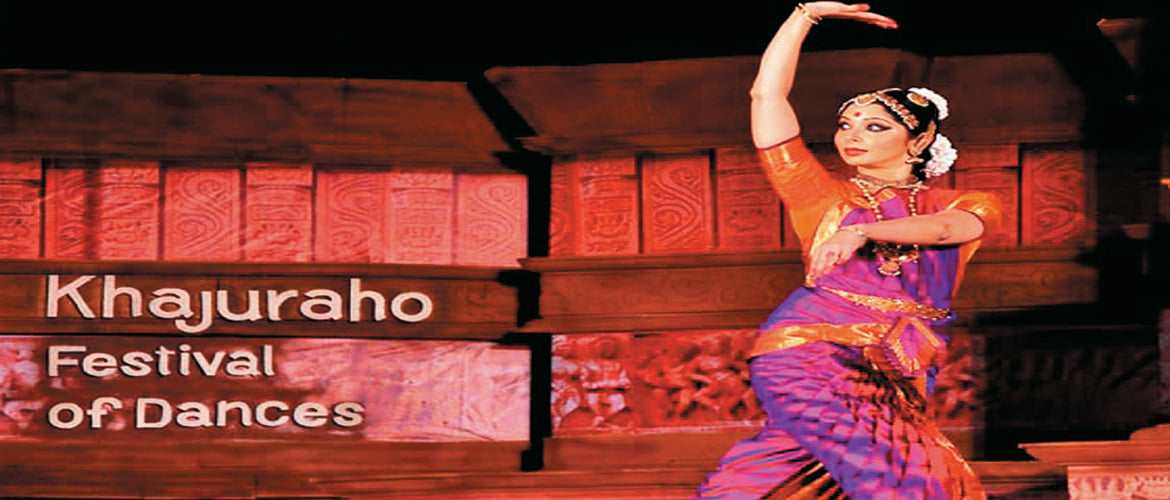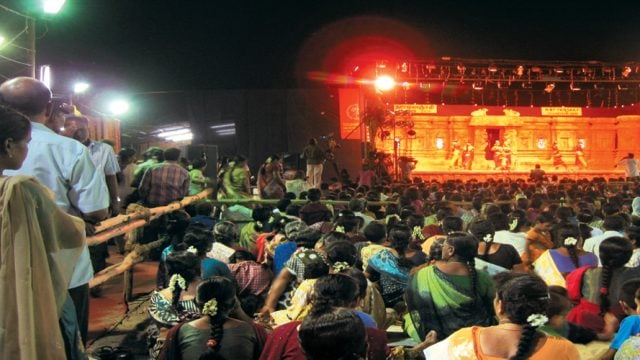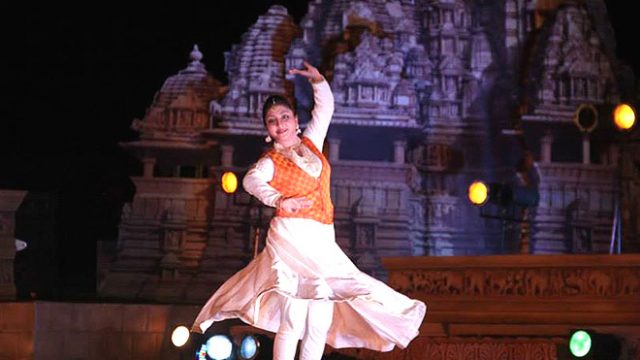Type Dance Festival Time 7 days in February Location Khajuraho, Madhya Pradesh The centuries-old temples of
One of the highlights of the 2016 edition of the festival was Padma Shree-recipient Ranjana Gauhar and her troupe’s Odissi act. The troupe presented Lord Krishna’s dalliances with Radha and other gopikas (milkmaids), a recurring theme in most Indian Classical dances.
Methil Devika’s Mohiniattam performance was awe-inspiring. Mohiniattam means ‘dance of the enchantress’ and Devika was just that. In one fluid motion, her expressions would change from that of a fierce rakshasa (demon) to a timid lamb.
The not-so-classical performance was by Madhu Nataraj and troupe. Trained in both Kathak and contemporary dance forms, she has developed her distinctive style that blends elements of jazz and aerobics with Kathak, while retaining the latter’s narrative form and grace. Like Madhu Nataraj, many of the performers at the festival are not only leading exponents and scholars of their art form, but also innovators who try to push the boundaries and possibilities of traditional dances.
Sukant Acharya and Group’s performance of the Seraikela Chhau was a treat for the audience as this martial dance is not much seen outside the Seraikela region of Jharkhand. The dancers wear elaborate masks and there is no vocal accompaniment – only instrumental music is played. Consquently, it is solely the body movements of the artists that convey the narrative and the mood and sentiments of the characters the dancers represent.
Indian Classical and folk dances have been an integral part of the country’s culture for centuries, influencing other art forms and in turn, being moulded by them. This is probably the reason why after visiting the temples and marvelling at the sculptures during the day, when one watches the dances in the evening, one can’t help but feel as if those very sculptures have come alive and are performing in front of you.
The Natyashastra, an ancient enyclopaedic treatise on the arts, mentions that no festival is complete without the synergetic presence of music, dance, drama, fine arts and literature. Inspired by this belief, the festival has a variety of activities and events that gives visitors a holistic experience of Indian art. Apart from the dances, the highlights of the 2016 edition of the festival were an art conclave, exhibitions, panel discussions and interactive sessions.
Art Mart, the national art conclave, features a panorama of visual arts – from painting to sculpting, graphics and photography. It also serves as a centre where artists can meet potential buyers. In 2016, Art Mart displayed the oeuvre of 450 artists from India and 30 artists from 12 other countries.
Indigenous and traditional arts get an excellent platform at Hunar (meaning talent), a fête where one can see local artisans at work, creating exquisite handicrafts using raw materials such as clay, wood and metal. At the workshop, one can buy directly from artisans.

Kalavarta, (literally ‘art dialogue’)comprises panel discussions on the state of arts, their evolution and their future followed by question and answer sessions. The Chalchitra section features screenings of documentaries and short films on India’s artistic traditions, the techniques artisans use and biographies of renowned maestros followed by interactions with members of the cinematic fraternity.
In the Nepathya (literally ‘back-drop/ backstage of a show’) section, which highlights the traditional costumes, artefacts and culture of a different state each year, Manipur was the chosen state in 2016. Manipuri youth dressed in traditional attire talked about the geography, and culture of the state. There was also an exhibition of regional costumes, jewellery and headgear.
Around the venue
Khajuraho Group of Monuments
Although the temples of Khajuraho are known all over the world for their flagrant depiction of sex, they are also arhcitectural masterpieces. The temples were built by the Chandela dynasty between 900 and 1130 CE. The Chandelas, a Rajput dynasty that claimed descent from the moon, rose to rule in the 9th century CE and between the 10th– 14th century, were the most powerful regents in the region. After their empire fell, the temples became shrouded in obscurity until TS Burt, a British officer chanced upon them. Legend has it that there were originally 85 temples, of which only 25 have survived in various states of preservation.

The existing Khajuraho temples have been divided into three groups – the Western Group of Temples (which has the most important and impressive shrines), the Eastern Group and Southern Group. Most of the them are dedicated to either Vishnu or Shiva.
Entry Indians ₹10; Foreigners ₹250 Timings Sunrise–sunset
MP Tourism organises a ‘Light and Sound’ show at the Western Group of Temples. The life and times of the great Chandela kings come alive every evening in the 50 -minute-long show that is narrated in both Hindi and English.
Entry Indian Adults ₹200; Children below 10 Rs.80; Foreigners Adults Rs.500; Children below 10 ₹250 Timings October–March 6.30–7.30pm (English) & 7.40–8.40pm (Hindi); April–September 7.30–8.30pm (English) & 8.40–9.40pm (Hindi)
Adivart Tribal & Folk Art Museum
Tribal and folk artefacts from all over Madhya Pradesh, such as terracotta, metal craft, wood craft, paintings, jewellery and masks are on display at this museum. You can buy original paintings and prints in the store here.
Entry Free Timings 12:00–8:00pm Closed Monday and official holidays
Where to stay
Khajuraho may be a small town, but it has plenty of lodging options. From backpacker haunts and home-stays to 5-star hotels, the hotels here cater to all kinds of tourists. Most are within a kilometre of the Western Group of Temples.
Hotel Chandela (Tel: 07686-272355-64; Tariff: On request) has a restaurant, bar, spa, swimming pool and gym. The Lalit Temple View (Tel: 272111, 272333; Tariff: ₹11,000–75,000) boasts of an award-winning spa, a fine-dining restaurant and a bar. Radisson Hotel Khajuraho (Tel: 297044; Tariff: ₹5,500–20,000), and Ramada Khajuraho (Tel: 272302-03, 272843-45; Tariff: ₹6,800–10,500) are other luxury options.
MP Tourism’s Hotel Jhankar (Tel: 274063, 274194; Tariff: ₹2,590) is a well-equipped mid-range option. Euro Star Inn (Tel: 274341, Cell: 09981296029; Tariff: ₹1,500–2,950); Hotel Casa Di William (Tel: 274244, Cell: 09893398536; Tariff: ₹510–1,150); and Zen Hotel (Tel: 274228, 272408; Tariff: ₹800–1,500) are decent budget options.
For those who prefer homestays, there is Friends of Khajuraho (Cell: 9893454390; Tariff: ₹650–1,000, inclusive of breakfast), located right opposite the Brahma Temple.
Raja Café, Madras Coffee House, Shivam Restaurant, Mediterraneo and Lassi Corner are some of the popular eateries in Khajuraho.
FAST FACTS
Festival Organiser
Department Of Culture
Government Of Madhya Pradesh
Western Group Of Temples
Khajuraho
Cell: 09993310992
W khajurahodancefestival.com
Tourist Office
MP Tourism
Chandela Cultural Centre
Khajuraho
Tel: 07686-274051
STD code 07686
GETTING THERE
Air Khajuraho Airport (4km/ 15mins) is connected to Delhi and Varanasi. Taxis to the town cost ₹300–500
Rail Khajuraho Railway Station is connected to Delhi and all major cities across India. Taxi as above. Jhansi (172km/ 3.5hrs) is connected to Delhi by the Bhopal Shatabdi Express. Taxi charges approximately ₹2,500. Or opt for the MPSRTC’s Shatabdi Bus, which is synchronised with the arrival of the Shatabdi Express at Jhansi. It leaves around 11.00am for Khajuraho
Road NH75 and NH76 link Khajuraho to Orchha and Jhansi. Gwalior is linked to Jhansi by NH3 Bus There are plenty of regular as well as deluxe buses plying between Jhansi and Khajuraho
festivals of India
Khajuraho
Khajuraho Dance Festival




